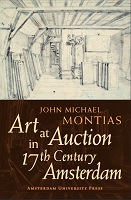Art at Auction in 17th Century Amsterdam
| dc.contributor.author | Montias, John Michael | |
| dc.date.accessioned | 2010-12-31 23:55:55 | |
| dc.date.accessioned | 2019-12-10 14:46:32 | |
| dc.date.accessioned | 2020-04-01T15:33:50Z | |
| dc.date.available | 2020-04-01T15:33:50Z | |
| dc.date.issued | 2002 | |
| dc.identifier | 340238 | |
| dc.identifier | OCN: 54391888 | en_US |
| dc.identifier.uri | http://library.oapen.org/handle/20.500.12657/35108 | |
| dc.description.abstract | This book exploits a trove of original documents that have survived on the auctions organized by the Orphan Chamber of Amsterdam in the first half of the 17th century. For the first time, the names of some 2000 buyers of works of art at auction in the 29 extant notebooks of the Chamber have been systematically analyzed. On the basis of archival research, data have been assembled on the occupation of these buyers (most of whom were merchants), their origin (Southern Netherlands, Holland, and other), their religion, their year of birth, their date of marriage, the taxes they paid and other indicators of their wealth. Buyers were found to cluster in groups, not only by extended family but by occupation, religion (Remonstrants, Counter-Remonstrants) and avocation (amateurs of tulips and of porcelain, members of Chambers of Rhetoricians, and so forth). The subjects of the works of art they bought and the artists to which they were attributed (only the most important were attributed) are also analyzed. In the second part of the book on "Selected Buyers", three chapters are devoted to art dealers who bought at auction and four to buyers who had special connections with artists, including principally Rembrandt. To forge a link between the cultural milieu of Amsterdam in this period and the buying public, two chapters are given over to buyers who were either poets themselves or were connected with contemporary poets. As a whole, the book offers a penetrating insight into the culture of the Amsterdam elite in the 17th century. | |
| dc.language | English | |
| dc.subject.classification | thema EDItEUR::A The Arts::AG The Arts: treatments and subjects::AGA History of art | en_US |
| dc.subject.classification | thema EDItEUR::N History and Archaeology::NH History | en_US |
| dc.subject.other | history of amsterdam | |
| dc.subject.other | geschiedenis | |
| dc.subject.other | kunst en kunstgeschiedenis | |
| dc.subject.other | history, geography, and auxiliary disciplines | |
| dc.subject.other | geschiedenis van amsterdam | |
| dc.subject.other | historical treatment of fine and decorative arts | |
| dc.title | Art at Auction in 17th Century Amsterdam | |
| dc.type | book | |
| oapen.abstract.otherlanguage | Tijdens de talloze veilingen die de Amsterdamse Weeskamer in de eerste helft van de Gouden zeventiende eeuw organiseerde, blijken het vooral koopmannen te zijn geweest, en dan met name uit de Zuidelijke Nederlanden en Holland, die hun goede geld investeerden in de aankoop van een Dürer of een Gerard Dou. Op basis van vele originele documenten die door de Weeskamer zijn overgeleverd, heeft professor J.M. Montias voor het eerst de achtergronden van zo'n 2000 zeventiende-eeuwse kopers van veilingkunst systematisch geanalyseerd. Hij verzamelde gegevens over hun beroep, hun afkomst, hun religie, hun geboortejaar en huwelijksdata, de belasting die ze betaalden en andere aanwijzingen over hun welvaart. Daaruit blijkt dat de kopers in verschillende groepen geclusterd waren. Een aantal van hen - waaronder ook de schilders Rembrandt en Rubens - komt in het boek uitgebreid aan bod. Daarnaast analyseert Montias de onderwerpen van de gekochte kunst en de kunstenaars waaraan de kopers gelieerd waren. | |
| oapen.identifier.doi | 10.5117/9789053565919 | |
| oapen.relation.isPublishedBy | dd3d1a33-0ac2-4cfe-a101-355ae1bd857a | |
| oapen.relation.isbn | 9789053565919 | |
| oapen.pages | 336 | |
| oapen.identifier.ocn | 54391888 |

